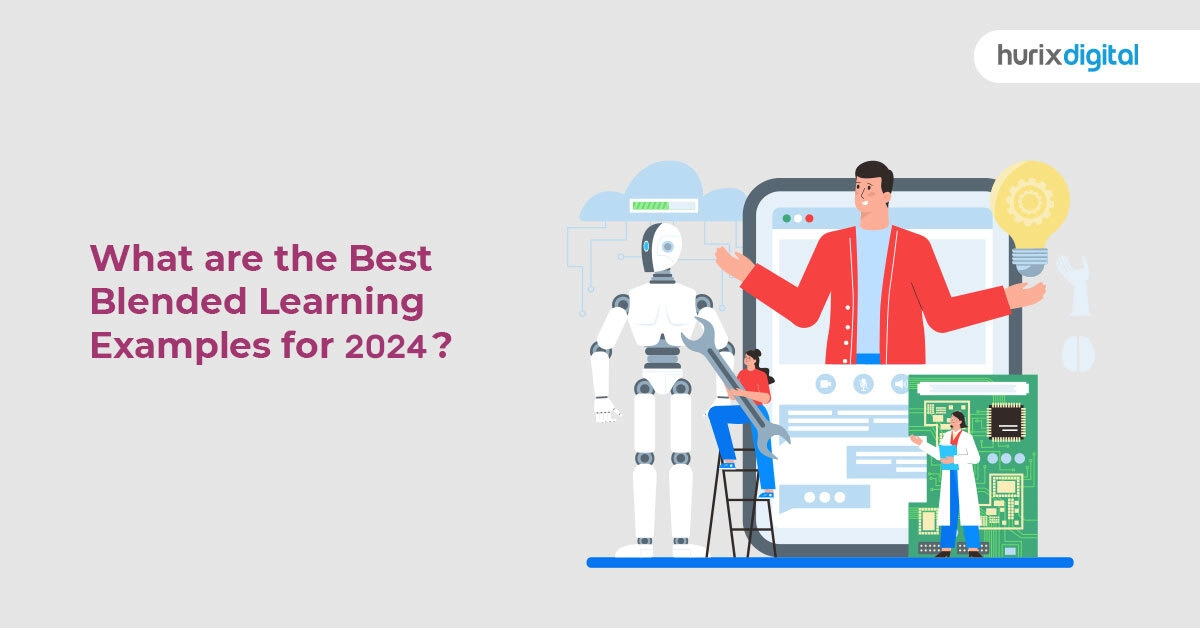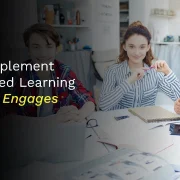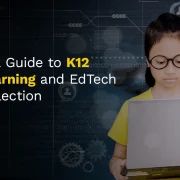
What are the Best Blended Learning Examples for 2025?
Discover the best blended learning approaches transforming modern education and corporate training. By combining the flexibility of digital tools with the structure of traditional classroom methods, blended learning creates a more personalized and engaging learning experience.
In this blog, we explore some of the blended learning examples across industries, from flipped classrooms and virtual labs to collaborative online modules and real-time feedback systems. These innovative strategies not only boost learner retention but also foster critical thinking and collaboration. Whether you’re an educator or a training professional, these insights will help you design impactful, future-ready learning programs that drive results.
Table of Contents:
- What is Blended Learning?
- What are the Top 10 Best Blended Learning Examples for 2025?
1. Flipped Classroom
2. Gamification
3. Personalized Learning
4. Collaborative Learning
5. Microlearning
6. Virtual Reality
7. Mobile Learning
8. Social Learning
9. Adaptive Learning
10. Blended Learning Platforms - Blended Learning Content – The Importance and Benefits for Your Business
- Conclusion
- Frequently Asked Questions (FAQs)
What is Blended Learning?
Blended learning, also known as hybrid learning, is a teaching method that combines traditional classroom instruction with online learning. It has gained popularity in recent years due to its flexibility, convenience, and ability to cater to different learning styles.
A study by the eLearning Industry found that 73% of organizations surveyed believed that e-learning helped them increase their competitive edge, and 60% believed that blended learning approaches were more effective than traditional classroom-based training.
Moreover, according to a report by Docebo, companies that implement blended learning solutions can see a 30% improvement in employee productivity and a 60% improvement in employee engagement.
What is a Blended Learning Method?
Blended learning is an educational approach that combines traditional in-person classroom instruction with online learning components and digital educational materials. This method allows students to learn through a mix of face-to-face interactions with teachers and peers, while also engaging with digital content and online activities at their own pace.
What are the Top 10 Blended Learning Examples for 2025?
1. Flipped Classroom
The flipped classroom is one of the most popular blended learning examples. In this method, students watch recorded lectures or video tutorials before attending class. During class, teachers focus on interactive activities such as discussions, problem-solving, and group work.
The flipped classroom method is highly effective because it enables students to learn at their convenient time and review difficult concepts before attending class. It also allows teachers to engage with students on a deeper level and provide individualized support.
2. Gamification
Gamification is another effective blended learning method. It involves incorporating gaming elements such as points, badges, and leaderboards into the learning process.
Gamification makes learning more engaging and purposeful for students and helps them retain information better. It also promotes healthy competition among students, which can improve motivation and participation.
3. Personalized Learning
Personalized learning is a method of teaching that addresses the unique needs and learning styles of each student. It involves using data analytics and technology to create personalized learning paths for each student.
This method enables teachers to provide targeted support based on individual learning needs. Personalized learning has been shown to improve student engagement and academic performance.
4. Collaborative Learning
Collaborative learning is an innovative teaching method that involves students working together in groups to solve problems or complete tasks. It promotes teamwork, communication, and critical thinking skills.
In a blended learning environment, collaborative learning can be facilitated through online platforms such as discussion forums, video conferencing, and collaborative document editing tools.
5. Microlearning
Microlearning is a method of teaching that delivers small, bite-sized lessons or modules. It is particularly effective for teaching specific skills or concepts.
Microlearning modules can be conveniently accessed online, and students can learn at their convenience. This method is ideal for busy students who do not have a lot of time for long lectures or assignments.
6. Virtual Reality
Virtual reality is an emerging technology that can be used to enhance blended learning. It involves creating a simulated environment that students can explore and interact with.
Virtual reality can be used to create immersive learning experiences that are not possible in a traditional classroom setting. For example, students can explore historical sites, scientific phenomena, or engineering designs in a virtual environment.
7. Mobile Learning
Mobile learning involves delivering learning materials to students via mobile devices such as smartphones or tablets. This method is particularly effective for students who prefer to learn on the go.
Mobile learning can be delivered through apps, videos, or interactive modules. It is an ideal method for busy students who need to study during their commute or between classes.
8. Social Learning
Social learning involves using social media platforms such as Twitter, Facebook, or LinkedIn to facilitate learning. Social media can be used to connect students with peers and experts in their field of study. It can also be used to share resources, ask questions, and collaborate on assignments.
Social learning can be particularly effective for students who are more comfortable with online communication than face-to-face interaction.
9. Adaptive Learning
Adaptive learning is a method of teaching that uses data analytics and technology to adjust the learning experience based on each student’s performance. It involves providing personalized feedback, recommendations, and resources to each student.
Adaptive learning can be delivered online, and it allows students to receive targeted support to improve their understanding of concepts.
10. Blended Learning Platforms
Blended learning platforms are tools that combine different learning activities, such as videos, quizzes, interactive activities, and assessments, into a single platform. They allow teachers to create and deliver customized learning experiences for their students.
Also read, Level-Up Your Training with a Combination of Microlearning and Mobile Learning
Blended Learning Content – The Importance and Benefits for Your Business
In today’s fast-paced business world, blended learning is becoming increasingly popular as it offers numerous benefits to both businesses and learners.
Blended learning content is designed to provide a flexible and efficient learning experience for learners while allowing businesses to save time and money.
The following are the importance of blended learning content for your business.
1. Increased Flexibility
Blended learning provides learners with the flexibility to learn at their own pace and at a time that suits them best. By offering online learning materials, businesses can allow learners to study at home, during their commute, or even during breaks at work.
This flexibility can be especially important for businesses that have employees working different shifts or in different time zones. With blended learning, learners can complete their coursework at a time that is convenient for them, reducing the pressure to fit their studies into a busy schedule.
WHITEPAPER:
Maximizing the ROI & Business Impact of Enterprise Learning
2. Cost-Efficient
Blended learning can be a cost-effective option for businesses as it eliminates the need for costly traditional classroom-based training.
Online learning materials can be created once and reused multiple times, reducing the cost of producing new content for each training session. Additionally, online learning eliminates the need for travel expenses and other associated costs, such as hiring instructors, renting classrooms, and providing materials.
3. Engaging Learning Materials
Blended learning content can be designed to be engaging and interactive. By incorporating multimedia elements such as videos, quizzes, and games, businesses can create a more dynamic and engaging learning experience for their employees.
This can help learners to stay focused and motivated, leading to better retention of information.
4. Real-Time Tracking and Analysis
Blended learning content can be used to track learners’ progress in real-time. Businesses can use learning management systems (LMS) to track learners’ completion of training modules, identify areas where learners are struggling and provide targeted support to learners who need it.
This data can be used to analyze a training program’s effectiveness and make improvements if needed.
Conclusion
Blended learning is a highly effective teaching method that combines the best of traditional classroom instruction with the flexibility and convenience of online learning.
The blended learning examples listed above are just a few of the many ways teachers can implement them in their classrooms in 2023. As technology advances, we hope to see more innovative and engaging blended learning methods emerge in the coming years.
Ready to implement blended learning examples in your organization? HurixDigital can help you create customized blended learning solutions that meet your unique training needs. Visit our website to learn more about our blended learning services, or contact us to discuss your requirements with our experts today.
Frequently Asked Questions (FAQs)
1. How can Blended Learning benefit businesses in terms of cost savings?
A. Blended learning reduces costs by eliminating the need for traditional classroom-based training, such as travel expenses, instructor fees, and material production. Online materials can be reused, further reducing expenses.
2. How does Blended Learning improve employee productivity?
A. Blended Learning can lead to a 30% improvement in employee productivity by offering flexible learning options that allow employees to acquire new skills and knowledge without disrupting their work schedules.
3. Can Blended Learning be customized for different industries?
A. Yes, Blended Learning can be customized to suit the specific needs and requirements of various industries, making it a versatile approach to training and education
4. How can businesses measure the effectiveness of their Blended Learning programs?
A. Businesses can measure the effectiveness of Blended Learning programs by using learning management systems (LMS) to track learner progress, gather feedback, and analyze data to make improvements.
5. Is Blended Learning suitable for teaching complex subjects like science or mathematics?
A. Yes, Blended Learning can effectively teach complex subjects like science and mathematics by combining online resources with interactive classroom activities, providing students with a well-rounded understanding of the material.

Senior Vice President
Julia brings over 20 years of global experience in digital learning and business strategy. She specializes in client success, enterprise learning solutions, and driving growth through innovation, with a focus on AI, VR, and emerging technologies across diverse industry verticals.




